Crude Oil Prices
-
- An Open Arctic and its Impact on Oil Drilling Marine News, Nov 2014 #58
William Cho, Head of MatthewsDaniel Weather, a division of the Bureau Veritas Group, explains why improvements in drilling technologies and weather monitoring systems have made offshore shelf drilling operations in the Arctic Circle increasingly attractive to upstream oil and gas companies and their investors.
Rising crude oil prices motivate not only technological innovators to explore cheaper alternative energy sources, such as solar panels and wind turbines, but also upstream oil and gas companies to explore new oil reserves which had not otherwise been economical. While the exact amount is less certain than highly developed areas, such as the North Sea or the Gulf of Mexico, the United States Geological Survey (USGS) estimated in 2008 that the Arctic contained about 412 billion barrels of undiscovered oil and oil equivalent.
The Arctic Circle area, in particular, has approximately 90 billion barrels of undiscovered but technically recoverable oil, 1,670 trillion cubic feet of technically recoverable natural gas, and 44 billion barrels of technically recoverable natural gas liquids. To put these amounts into context, they account for about 22 percent of the ‘not yet discovered but recoverable’ resources in the world. Drilling down into these figures, lying in the Arctic zone is one third of the world’s undiscovered but potentially recoverable natural gas reserves. With improvements in drilling technologies and weather monitoring systems, offshore shelf drilling operations in the Arctic Circle have become increasingly attractive to upstream oil and gas companies and their investors. USGS estimates that about 84 percent of these resources are offshore.
Melting Ice = Accessible Assets
In addition to technological advancements in identifying oil and gas pockets and new drilling methods, such as multilateral drilling, the declining ice extent in the Arctic Sea has enabled the exploration for minerals. An unprecedented amount of the Arctic ice melted in 2007, surpassing the previous record low ice in 2005 by 24 percent. Another record ice-melt was observed in the summer of 2012, leaving the Northwest Passage navigable. The next record low ice is expected to occur in 2015 or 2016. These findings signify that Mobile Offshore Drilling Units (MODUs) will be able to undertake voyages to areas previously inaccessible, and drilling contractors will also have longer drilling seasons.
MatthewsDaniel Weather monitors melting ice in the Kara Sea and the Chukchi Sea to calculate an estimated beginning and ending date for offshore drilling seasons. The Kara Sea (‘Ка́рское мо́ре’ in Russian) forms part of the Arctic Ocean north of Siberia and has a mean water depth of 110 meters (360 feet). Although the sea is ice-bound for about ten months of the year, a significant amount of untouched petroleum and natural gas reserves lie in the East-Prinovozemelsky field, an extension of the West Siberian Oil Basin. Estimated recoverable resources in East Prinovozemelsky Blocks 1, 2 and 3 are almost 21 billion tons of oil equivalent.
The Chukchi Sea (‘Чуко́тское мо́ре’ in Russian), on the other hand, is a marginal sea of the Arctic Ocean and is bounded on the west by the De Long Strait, off Wrangel Island, and in the east by Point Barrow, Alaska. About 56 percent of its total area has a water depth of less than 50 meters (164 feet), and the sea is open (navigable) about three and a half months of the year on average. The oil and gas reserve in the Chukchi Sea is estimated to be as high as 30 billion barrels of oil and gas. Several oil companies have been bidding for extraction rights, for around US$2.6 billion.
Science Supports Seasonal Drilling
MatthewsDaniel Weather analyzed significant wave data in both the Kara and Chukchi Seas over three time periods: 1979 to 1989, 1990 to 1999, and 2000 to 2012, to determine the lengths of past drilling seasons. Jill Hasling, Chief Consulting Meteorologist at MatthewsDaniel, states, “In addition to the retreat of the ice in the Kara Sea, the Kara Gate needs to be ice-free (less than 15 percent ice in the region) in order to enable mobilization.” Based on this research, Jill and her team were able to identify the historic potential drilling windows for the Kara Sea and the Chukchi Sea. Drilling seasons are determined by the retreat and return of ice in the Marginal Ice Zones (MIZ). MIZ is beyond the extent of the year-round pack ice.
Combining this analysis of past drilling seasons with current daily plots of the sea ice extent and meteorological conditions, MatthewsDaniel Weather developed a methodology for predicting start and end dates of future drilling seasons. In May 2014, it forecast that the 2014 Arctic drilling season would start on July 25 and continue until October 25 for the Kara Sea and from July 18 to October 25 for the Chukchi Sea. The actual ice-free period (less than 15 percent ice in the region) began on August 4 for the Kara Sea and on July 25 for the Chukchi Sea.
James Vavasour, Executive Vice President at MatthewsDaniel, said, “It is still too early to accurately identify the end of the season, but we expect it will be within ten days of the prediction we made in May. We can, with a degree of confidence, estimate next year’s drilling season; for the Kara Sea, beginning on August 4 and ending on October 30, and from July 25 to November 2 for the Chukchi Sea.”
What does this mean for Industry?
Certain risks in the Arctic Sea are obvious, such as potential freezing of fluids and winterizing equipment due to extremely cold temperatures. Other considerations are remoteness in an already isolated region, communication challenges, collision risk with drifting icebergs, and weather delays while retrieving drilling equipment from the ocean at the end of the season. S Douglas Devoy, President of MatthewsDaniel in Houston, adds, “A number of separate and significant issues come into play when having to mobilize a mobile offshore drilling unit and, of course, its support and supply vessels into the Arctic. These include ice and potential heavy weather, which might come into play late in the season. The more accurately we can predict or model these, the better the industry can prepare to meet these difficult circumstances.”
Further analysis shows that the frequency of Arctic storms has increased due to more atmospheric interactions with the open sea. Arctic storms expedite the melting process by breaking up the ice cover. NASA’s Arctic storm track maps contrast storm frequency between 1950-1972 and 2000-2006, showing a marked increase.
On a broader view, the ability to predict the drilling window will undoubtedly enable companies to fine-tune their mobilization programs, and benefit from a higher degree of certainty on expenditure planning. However, the weather analysis can have more specific influence on operations. During the planning stage of mobilizing a vessel to the Arctic, MatthewsDaniel Weather would provide SafeTrans voyage route simulations, based on captains’ decision mimics and probabilistic environmental wind and wave condition reports. During the actual voyage, the Weather team would provide the mobilization team with twice-daily forecasts for the following eight days for more inclusive, ‘real-time’ planning and decision-making.
MatthewsDaniel demonstrates its commitment to risk mitigation in the Arctic environment through its contribution to SALTO: Safe Arctic Logistics, Transport & Operation. This Joint Industry Project aims to offer risk-based tools to assist the industry with its preparations for operating in Arctic environmental conditions.
The three factors that would make the exploration of Arctic reserves attractive to investors and upstream oil and gas companies are high commodity prices and technological feasibility, coupled with favorable environmental conditions. The first two criteria are met by the global rise of crude oil prices since 2009 and industry-wide investment and innovation in drilling technology. These technological solutions have made it feasible and more cost-effective to explore remote or difficult reserves and produce with fewer installations. The key that is specific to the Arctic is the lengthening of the drilling season, due to warming waters and increased storm activity.
Considered alongside these commercial factors are potential positive and negative impacts on local economies, environmental risks such as ecosystem disturbance and oil spill and political sensitivities. The mood and appetite is to accept the challenges that this harsh region represents. And, science and nature can combine forces to minimize risk and promote a safer operating environment.
(As published in the November 2014 edition of Marine News - http://magazines.marinelink.com/Magazines/MaritimeNews)
-
- Astronomical Drilling Rig Prices Anticipated Because Of Worldwide Demand Maritime Reporter, Apr 1991 #60
that are under way simultaneously in many oil producing nations. Kuwait, in addition, is expected to need an unspecified number of rigs to restore its crude oil output after hundreds of its wells were damaged or destroyed by Iraq's occupying forces. The growing U.S. demand for rigs is also putting
-
- As Operators Look for the Bottom, Gulf Gloom Persists Marine News, Nov 2016 #38
vessel operators want to see sustained, higher oil prices. After a rough two years, supply boat owners and operators in the Gulf of Mexico hope crude oil prices will improve in 2017. That would encourage activity among the offshore drillers that they service and would put unemployed boats back in the water
-
- Interview: Chia Yoo Soon, Chevron Marine Lubricants Maritime Reporter, Jan 2018 #24
a prolonged down cycle, with companies adjusting to the ‘new normal.’ But the oil downturn has not been as bad as the shipping slump. Even though crude oil prices have remained low, we are seeing increases in lubricant component costs. As you know, lubricants are comprised mainly of two major components
-
- Oil’s Downward Spiral Stalls LNG’s Ascent Maritime Reporter, Jun 2015 #34
and bunker pricing and infrastructure are influencing the business plan for LNG. Hammer Time The most evident impact has been in pricing. Crude oil prices have been dropping precipitately since mid- 2014, from $115/barrel in June to $70 by December to as low $48 and change last month – a roughly
-
- Shipbuilding’s Dilemma: Good Problems to Have. Maritime Logistics Professional, Q4 2014 #8
trends, then U.S. yards should today be considered the industry’s market leaders, as well. Notwithstanding the recent (and dramatic) drop in global crude oil prices, the ongoing, so-called ‘domestic energy boom’ has left American shipyards with as many as 30 deep draft vessels on their collective backlogs
-
- Marine News January 2015 - Editor's Note Marine News, Jan 2015 #6
included – celebrate lower bunker prices, another maritime subset frets over what might happen to the offshore service market if the downturn in crude oil prices continues unabated for a significant length of time. That said; if your market focus is ferries and/or passenger vessels, then you won’t find
-
- Oil Instability, consolidation Muddy Offshore E&P Picture Maritime Reporter, Nov 2000 #27
by Lehman Brothers. "But in the longer-term, we do feel that technology will tend to drive price down" to $20 a barrel or less, he added. Crude oil prices presently stand above $30 a barrel, having recovered from $10 a barrel in 1998, and companies including Shell are now looking to funnel some
-
- Gastech 78 LNG/LPG Conference Includes Major Paper From OPEC Maritime Reporter, Aug 1978 #7
pricing activities have been very much in the public eye ever since the round of price increases started in 1974, which led to a quadrupling of crude oil prices, the Gastech 78 meeting will be the first public platform for the announcement of OPEC's next aim—price fixing for LPG and LNG. With
-
- Market Snapshot: Offshore Outlook Marine News, Sep 2017 #44
Notwithstanding the recent surge in crude oil prices, it isn’t lost on anyone that the offshore oil exploration business is, and has been for some time, in the doldrums. In the U.S. Gulf, that pain can be seen through Chapter 11 filings and the sobering specter of vessel after vessel rolling off the shipyard
-
- Energy Sector Volatility Affects Middle Market M&A Activity Maritime Logistics Professional, Q4 2014 #16
seems to surprise even the best analysts more often than not. Figure 1 displays a comparison of marine and offshore M&A deal flow with average world crude oil prices over the past ten years. Financial markets as defined by deal flow tended to slightly lead, or anticipate the upward surge in oil prices between
-
- Offshore O&G: Weathering the Storm Marine News, May 2015 #34
of Petroleum Exporting Countries (OPEC), and the group has continued to churn out oil at a steady rate even though European demand has eased. Crude oil prices in New York hovered at $52 a barrel in early April, down from $102 last August. Offshore industry will rebound longer term “Looking at oil
-
 )
March 2024 - Marine Technology Reporter page: 42
)
March 2024 - Marine Technology Reporter page: 42NEW TECH OCEANOLOGY INTERNATIONAL 2024 Image courtesy Greg Trauthwein Image courtesy BIRNS MacArtney launches the new ultra-compact ø12.7 mm SubConn Nano connector. Innovative connectivity built on 45 years of ? eld-proven and market-trusted design. Image courtesy MacArtney Birns celebrated its 70th
-
 )
March 2024 - Marine Technology Reporter page: 39
)
March 2024 - Marine Technology Reporter page: 39Photo courtesy Global Ocean Design Figure 7 A 35Ah AGM lead-acid battery is tested using the West Mountain Radio CBA to show the effect of simply ? lling the battery voids with mineral oil as a compensating ? uid. The CBA is programmed to cut-off at a voltage of 10.50v. The top line (red) shows the
-
 )
March 2024 - Marine Technology Reporter page: 36
)
March 2024 - Marine Technology Reporter page: 36LANDER LAB #10 Of special interest for marine applications, LiPo batteries are Shipping any kind of lithium battery can be a challenge, and offered in a “pouch” design, with a soft, ? at body. The pouch IATA regs vary with the batteries inside or outside an instru- is vacuum-sealed, with all voids ?
-
 )
March 2024 - Marine Technology Reporter page: 35
)
March 2024 - Marine Technology Reporter page: 35Figure 1 A self-righting vehicle design with buoyancy high and weight low, WHOI’s SeaBED AUV captures the attention of a pair of curious Antarctic penguins as it is deployed from the British research vessel James Clark Ross. Vehicle designers allowed for temperature reduction of battery capacity. Recharge
-
 )
March 2024 - Marine Technology Reporter page: 33
)
March 2024 - Marine Technology Reporter page: 33all of the negative feedback that the industry has received.” Still, the pushback continues. A 2023 Planet Tracker report highlighted that, like crude oil, nodules take millions of years to form, so biodiversity loss would essentially be permanent. And in Feb- ruary 2024, the European Parliament
-
 )
April 2024 - Maritime Reporter and Engineering News page: 47
)
April 2024 - Maritime Reporter and Engineering News page: 47MARKETPLACE Products & Services www.MaritimeEquipment.com Powering the fleet for 60 years! HYDRAULIC NOISE, SHOCK AND VIBRATION SUPPRESSOR Noise, Shock, VibraO on & PulsaO on in Quiet, Smooth Flow Out Oil Bladder Nitrogen (blue) Manufactured by MER
-
 )
April 2024 - Maritime Reporter and Engineering News page: 41
)
April 2024 - Maritime Reporter and Engineering News page: 41Nautel provides innovative, industry-leading solutions speci? cally designed for use in harsh maritime environments: • GMDSS/NAVTEX/NAVDAT coastal surveillance and transmission systems • Offshore NDB non-directional radio beacon systems for oil platform, support vessel & wind farm applications
-
 )
April 2024 - Maritime Reporter and Engineering News page: 38
)
April 2024 - Maritime Reporter and Engineering News page: 38Tech Files Latest Products, Systems and Ship Designs Zero-Emission Mooring Service of a Tanker Consulmar achieved a milestone by executing what it calls ing boat Castalia, which operates on full electric propulsion. the world's ? rst zero-emissions mooring service for a tanker. Equipped with two 150 kW
-
 )
April 2024 - Maritime Reporter and Engineering News page: 35
)
April 2024 - Maritime Reporter and Engineering News page: 35SIMULATION e have a close relationship with tech- Realism is prized beyond immersive, photo-realistic visu- nology, evidenced by, for example, als, and providers are introducing increasingly accurate func- the phones we are estimated to un- tionality. FORCE Technology’s upcoming DEN-Mark2 math- lock around
-
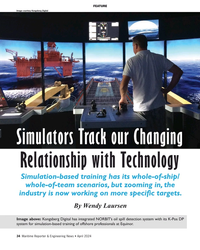 )
April 2024 - Maritime Reporter and Engineering News page: 34
)
April 2024 - Maritime Reporter and Engineering News page: 34FEATURE Image courtesy Kongsberg Digital Simulators Track our Changing Relationship with Technology Simulation-based training has its whole-of-ship/ whole-of-team scenarios, but zooming in, the industry is now working on more speci? c targets. By Wendy Laursen Image above: Kongsberg Digital has integrated
-
 )
April 2024 - Maritime Reporter and Engineering News page: 32
)
April 2024 - Maritime Reporter and Engineering News page: 32FEATURE A closeup of a blade installation process taken via drone. A blade handling system is apparent (in yellow). Images courtesy of Mammoet requirement for the development of these cranes, particularly ling area. This would result in a major time and fuel saving. in ? oating offshore wind,” says
-
 )
April 2024 - Maritime Reporter and Engineering News page: 25
)
April 2024 - Maritime Reporter and Engineering News page: 25RADM PHILIP SOBECK, MILITARY SEALIFT COMMAND Photo by Brian Suriani USN Military Sealift Command From a global supply chain perspective, What makes MSC so vital to the we’ve learned a lot about dealing with Navy’s ? eet and our military disruptions. COVID delivered a big forces around the world? wake-up
-
 )
April 2024 - Maritime Reporter and Engineering News page: 21
)
April 2024 - Maritime Reporter and Engineering News page: 21ROB LANGFORD, VP, GLOBAL OFFSHORE WIND ob Langford has worked in the offshore industry ABS. “We are growing and evolving our services across all for more than three decades, ‘cutting his teeth’ offshore infrastructure along with our continued support to the in a UK design ? rm working in the North Sea
-
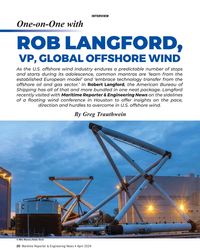 )
April 2024 - Maritime Reporter and Engineering News page: 20
)
April 2024 - Maritime Reporter and Engineering News page: 20INTERVIEW One-on-One with ROB LANGFORD, VP, GLOBAL OFFSHORE WIND As the U.S. offshore wind industry endures a predictable number of stops and starts during its adolescence, common mantras are ‘learn from the established European model’ and ‘embrace technology transfer from the offshore oil and gas
-
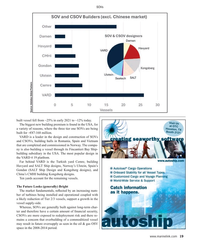 )
April 2024 - Maritime Reporter and Engineering News page: 19
)
April 2024 - Maritime Reporter and Engineering News page: 19SOVs Source: Intelatus Global Partners built vessel fell from ~25% in early 2021 to ~12% today. Visit Us The biggest new building premium is found in the USA, for at OTC Houston, TX a variety of reasons, where the three tier one SOVs are being Booth 2121 built for ~€87-168 million. VARD is a leader in
-
 )
April 2024 - Maritime Reporter and Engineering News page: 18
)
April 2024 - Maritime Reporter and Engineering News page: 18MARKETS & gas activity returns, we anticipate that supply of the vessels The Question of Emissions to offshore wind projects will reduce, driving demand for ad- Given that SOVs and CSOVs operate in a segment target- ditional CSOVs. ing reduced emissions, and many operate in the North Eu- Outside of China
-
 )
April 2024 - Maritime Reporter and Engineering News page: 17
)
April 2024 - Maritime Reporter and Engineering News page: 17SOVs China, we do not look at demand for SOVs/CSOVs as having a linear rela- tionship to the number of wind farms or turbines installed. We look to see where a large number of wind turbines are concentrated in relatively close proximity, generally in a very large wind farm or in a project cluster
-
 )
April 2024 - Maritime Reporter and Engineering News page: 16
)
April 2024 - Maritime Reporter and Engineering News page: 16MARKETS SOVs – Analyzing Current, Future Demand Drivers By Philip Lewis, Director of Research, Intelatus © Björn Wylezich/AdobeStock t a high-level, there are three solutions to transferring Lower day rate CTVs are often used for daily transfer of technicians from shore bases to offshore wind farms
-
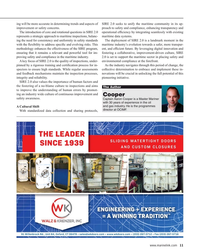 )
April 2024 - Maritime Reporter and Engineering News page: 11
)
April 2024 - Maritime Reporter and Engineering News page: 11ing will be more accurate in determining trends and aspects of SIRE 2.0 seeks to unify the maritime community in its ap- improvement or safety concerns. proach to safety and compliance, enhancing transparency and The introduction of core and rotational questions in SIRE 2.0 operational ef? ciency by
-
 )
April 2024 - Maritime Reporter and Engineering News page: 10
)
April 2024 - Maritime Reporter and Engineering News page: 10Maritime Safety © Roman/AdobeStock SIRE 2.0: Navigating the New Horizon of Maritime Safety By Captain Aaron Cooper, Programs Director, OCIMF he maritime industry is on the cusp of a signi? cant preparing vessel operators and vessel assurance teams for the transformation with the launch of the Ship
-
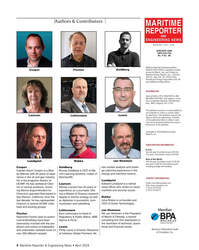 )
April 2024 - Maritime Reporter and Engineering News page: 4
)
April 2024 - Maritime Reporter and Engineering News page: 4Authors & Contributors MARITIME REPORTER AND ENGINEERING NEWS M A R I N E L I N K . C O M ISSN-0025-3448 USPS-016-750 No. 4 Vol. 86 Maritime Reporter/Engineering News (ISSN # 0025-3448) is published monthly Cooper Fischer Goldberg except for March, July, and October by Maritime Activity Reports, Inc.
-
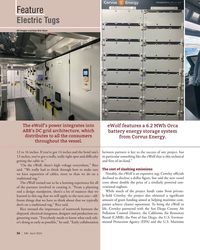 )
April 2024 - Marine News page: 34
)
April 2024 - Marine News page: 34Feature Electric Tugs All images courtesy Eric Haun The eWolf’s power integrates into eWolf features a 6.2 MWh Orca ABB’s DC grid architecture, which battery energy storage system distributes to all the consumers from Corvus Energy. throughout the vessel. 12 to 16 inches. If you’ve got 14 inches and
-
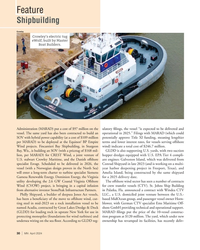 )
April 2024 - Marine News page: 30
)
April 2024 - Marine News page: 30Feature Shipbuilding Crowley Crowley’s electric tug eWolf, built by Master Boat Builders. Administration (MARAD) put a cost of $97 million on the ulatory ? lings, the vessel “is expected to be delivered and vessel. The same yard has also been contracted to build an operational in 2025.” Filings with
-
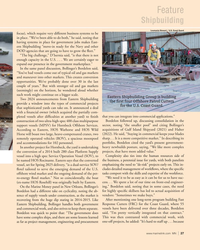 )
April 2024 - Marine News page: 27
)
April 2024 - Marine News page: 27Feature Shipbuilding Loumania Stewart / U.S. Coast Guard focus), which require very different business systems to be in place. “We’ve been able to do both,” he said, noting that having systems in place for government jobs makes East- ern Shipbuilding “move-in ready for the Navy and other DOD agencies
